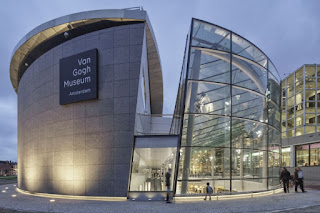The bulk of our time was spent on foot, walking the city. I've got dozens of oddball notes jotted down regarding remarkable places we visited, but nothing by way of an organizing principle. One month later, I still don't have one. I think this relates to the actual locale. People of Dutch descent might have a reputation for being fastidious to a fault, but if there's an organizing principle to contemporary Amsterdam, I failed to locate it. It's an endearingly kooky place.*
I tend to think just about everything in the "not-to-be-missed" category is, in fact, negotiable. But really, the Van Gogh Museum is not to be missed -- especially now, while it is still hosting the Munch : Van Gogh exhibit.
Vincent Van Gogh, eh? What to make of this guy's enduring popularity? When you're standing in line waiting to get in -- on an early, off-season Wednesday morning -- it's a mystery with no small element of vexation involved.
But seeing the actual work, as opposed to photographs of it, goes a great distance to explaining the appeal. For instance, a terrific photo of The Lover (Portrait of Lieutenant Milliet) (source) . . .
. . . can do a great deal to communicate the texture and visual effect of the painting. But seeing the actual painting, framed and sensitively lit, is more akin to facing an incredible piece of sculpture.
Mm . . . "facing" isn't quite the right word. "Being in the presence of," gets closer to the effect you experience.
This sort of pointy-headed musing can put a person off the habit of attending to anyone's paintings, but there is a considerable cache of charm associated with Van Gogh. The work alone is always accessible -- there's no question, ever, regarding exactly what you're looking at. It is also frankly and immediately emotional.
The emotional element really comes out, especially if you view Van Gogh after spending a day with "The Dutch Masters" in the Rijksmuseum. Rembrandt's massive group portraits -- commissioned, of course -- are terrifically impressive. But they are also of a piece with the times, when the recently wealthy princes of commerce were keen to be immortalized in paint. Ditto, the actual rulers and their military commanders. Powerful, opulent prigs, towering above the viewer for as long as paint shall last. In contrast, Van Gogh's pieces are small, punchy and immediate.
"Immediacy" and "punch" are qualities Munch's stuff has as well -- in spades. Though he tends to read a bit cooler, I think. Van Gogh could be guilty of "making a point" in his work, but nowhere near to the degree that Munch did.
Seeing the two side-by-side is quite the experience. If you can manage it, you should, because these cats drew the lines we've been colouring in ever since. On until January 17, 2016.
 |
| It's less busy when it's closed, of course. |
*So long as you give the Red Light District -- or the entire city center, really -- a wide berth on Friday and Saturday night. Honestly, how is it the Scots and Irish haven't drunk themselves into extinction?



2 comments:
>>>how is it the Scots and Irish haven't drunk themselves into extinction?
I hang out with a lot of Scots and Irish (and English) here in expatriate land. And I can also attest that they drink a lot heavier than us North Americans.
For their part, they're just as puzzled by my tendency to resist getting drunk every night. It's been an interesting cultural exchange.
It's a condition that gets them ready to mix it up, alas, especially when they're grouped together. It's like being physically present in that Star Trek episode.
Post a Comment